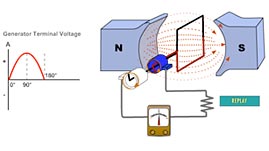Teachers' Domain - Digital Media for the Classroom and Professional Development
User: Preview

Source: WISCONLINE
In this interactive resource adapted from the Wisconsin Online Resource Center, learn how a generator produces alternating current. More specifically, see how slip rings, brushes, an armature loop, and a magnetic field interact to produce single-phase alternating current. Animations show how positive and negative voltages are induced into the armature loop as it rotates through the magnetic field, and how the polarity of the voltage changes periodically, visualized as a sine wave.
Electricity is the flow of electrons that powers much of modern life's appliances. Light bulbs, computers, refrigerators, and many other devices run on electricity. Some products may use batteries as a source of electricity, but the majority of the electricity we use comes from power plants (also known as a power stations). Power plants convert energy from other sources into electricity and then distribute the electricity over long distances to homes and businesses through power lines.
Steam turbine generators are one of the most common methods to produce electricity. A generator utilizes the relationship between electricity and magnetism to convert mechanical energy into electrical energy. When an electric conductor (such as a loop of wire) and a magnetic field move relative to each other, a voltage is induced in the conductor.
A turbine consists of fan blades attached to a rotor assembly. When steam from boiling water hits the blades of the fan, the turbine is forced to rotate. The rotational motion is conducted along a shaft to the generator, where loops of wire attached to the shaft spin through a magnetic field; alternatively, the rotational motion may cause a magnet to spin within one or more coils of wire. The relative motion between the wire and the magnetic field generates electricity through the conductor.
The combustion of fossil fuels (such as coal, oil, or natural gas) typically produces the heat that is used to boil water to make steam. However, there are a number of other possible heat sources. For example, geothermal power plants utilize the natural heat energy of Earth's interior to heat water flowing through underground pipes. Nuclear power plants use the heat from nuclear reactions. Solar thermal power plants can generate electricity by using energy from sunlight to boil water. Alternatively, moving water is used to turn the blades of water turbines, such as those found in hydroelectric power plants. Likewise, moving air is used to turn the blades of wind turbines.
Electric generators used in power plants are much larger and produce more power than the portable electric generators one might use for camping or at home during a power outage. Portable generators typically are only a couple of feet long and produce between 1 and 15 kilowatts of power (a watt is a measure of how much energy is used per second). In contrast, an industrial turbine may be over 100 feet long and can generate hundreds of megawatts of power. Portable generators also differ from the generators used in power plants in that they produce single-phase power; power plants generate three-phase power using three loops. The three single phases (loops) are physically offset by 120 degrees so that at all times, one of the phases is nearing a peak, which provides nearly continuous power output.
 Loading Standards
Loading Standards Teachers' Domain is proud to be a Pathways portal to the National Science Digital Library.
Teachers' Domain is proud to be a Pathways portal to the National Science Digital Library.
